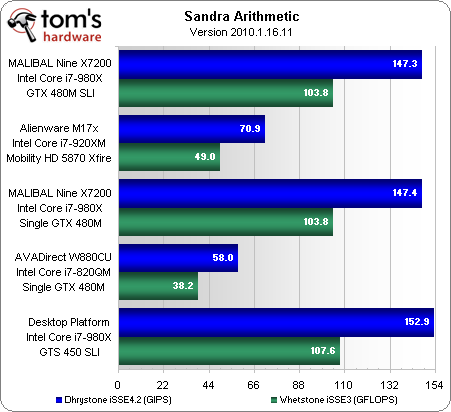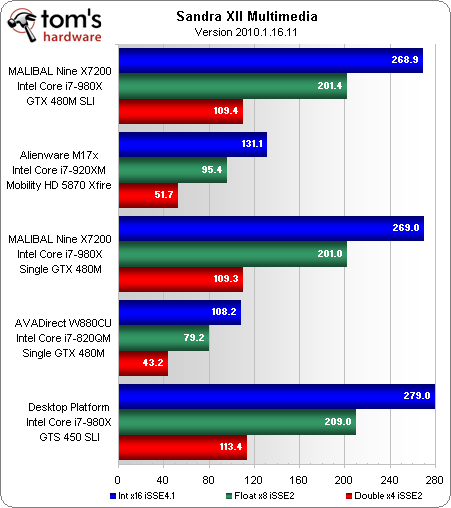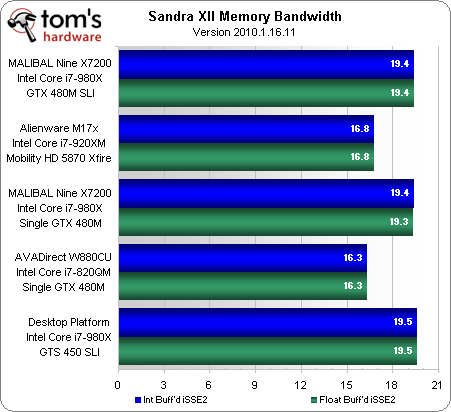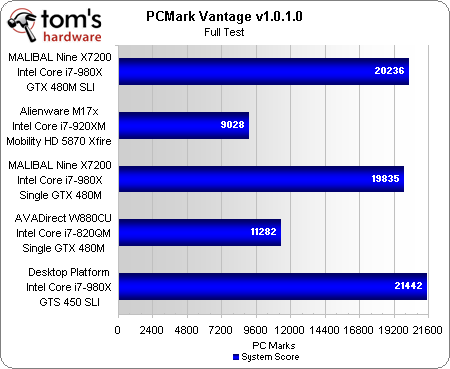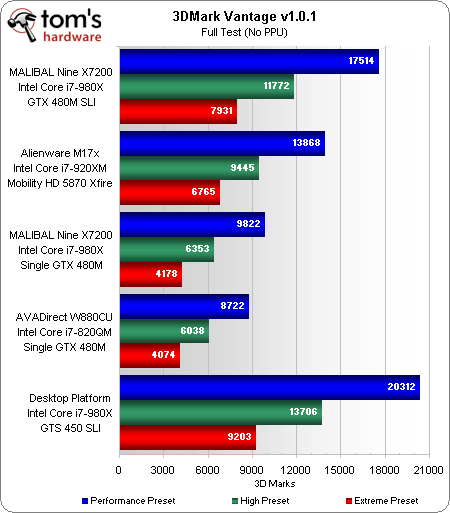Is That A Notebook? MALIBAL's Six-Core, Dual-GPU, Speed Demon
Combining top-end desktop and notebook components, the MALIBAL Nine X7200 is the workstation you can take with you. Today we see how it compares to our fastest “desktop replacement” notebook, and how well it stands up to a similarly-configured desktop PC.
Benchmark Results: Synthetics
Sporting a desktop Core i7-980X processor, the X7200 creates its own performance class in notebooks. The only fair comparison would be to itself, using single GPU data to show the advantage of SLI.
Some readers will want to know exactly how much more powerful the desktop processor is, and Alienware’s most recent M17x represents our best-performing previously-reviewed notebook.
A combination of more cores and higher clock speed allow the MALIBAL Nine X7200 to solidly trounce any notebook that uses a mobile processor. On the other hand, the desktop platform edges it out in spite of the fact that it’s underclocked from the correct 133.3 MHz base clock to 133.0 MHz.
Triple-channel mode isn’t supported by Intel’s notebook platforms, but the X7200’s motherboard uses desktop parts to enable it. This allows MALIBAL to triumph over Alienware, in spite of its rival’s tighter timings. The desktop system uses a mixture of modules to reach the same capacity, frequency, and timings as MALIBAL’s notebook, yet its bandwidth is still slightly higher.
PCMark benefits from the X7200’s striped SSD drives as well as its more powerful processor and wider memory bus. Plugging the same drives into the desktop platform allowed it to gain even more, however, in spite of the identical chipset, CPU, and memory settings.
Further analysis of the score points directly at Clevo’s implementation of Intel’s RAID controller, as the HDD scores (not shown) were 45886 for the desktop platform and 35596 for the X7200 notebook.
All of today’s charts are arranged by notebook GPU power, with the desktop’s non-notebook part keeping it out of the loop. SLI scaling over 80% for the second GeForce GTX 480m makes the X7200 look spectacular, while an even bigger lead for a pair of desktop-class GeForce GTS 450 graphics cards causes us to once again question Nvidia’s mobile-graphics naming scheme.
Get Tom's Hardware's best news and in-depth reviews, straight to your inbox.
Current page: Benchmark Results: Synthetics
Prev Page Test Settings Next Page Benchmark Results: Audio And Video Encoding-
compton I'm not sure how awesome this is in practice. I'm sure someone out othere needs this, but that person would have to be blind to appreciate the asthetics.Reply -
iam2thecrowe its more of a portable pc than a notebook. look at the power consumption. Even its own power adaptor cant keep up at max load.Reply -
Darkerson In this case, its not really about looks, as much as its about "portable" brute strength. And it seems to have plenty of that...Reply -
thats actually really good performance from a top end systemReply
at most rates it is still fairly close to a desktop in price also -
maxiim This quite useless if you want all that power for gaming, you surely cant have it on the go with a battery provided....might as well build a with almost the same specs for less money.Reply -
compton Its the same price as a base model Kia Rio just about. Kudos to them for the engineering needed to make this gear work in a mobile chassis. I may not be sold on the concept, or see the need of, but I hope they sell a ton of them. It is kinda cool just because its so powerful -- but for the price you could build or buy two highly specialized systems. It could be a mobile workstation or for AV production work on site instead of just for gaming. Clearly these ultra powerful 'notebooks' are a niche segment, but there are quite a few now. Someone must be buying them.Reply -
sudeshc Not that impressive to me main reason for Lappy is portability and thats where this lacks i wounder even if under no load how much heat it would generate and also the battery wont last long..Reply -
Crashman comptonIt could be a mobile workstation or for AV production work on site instead of just for gaming. Clearly these ultra powerful 'notebooks' are a niche segment, but there are quite a few now. Someone must be buying them.Actually, that's what the X7200 is! Tom's Hardware got the "gaming" version simply to show off its capabilities to enthusiasts, but the Quadro versions are equally viable (and likely more valuable) in their own respective markets.Reply
